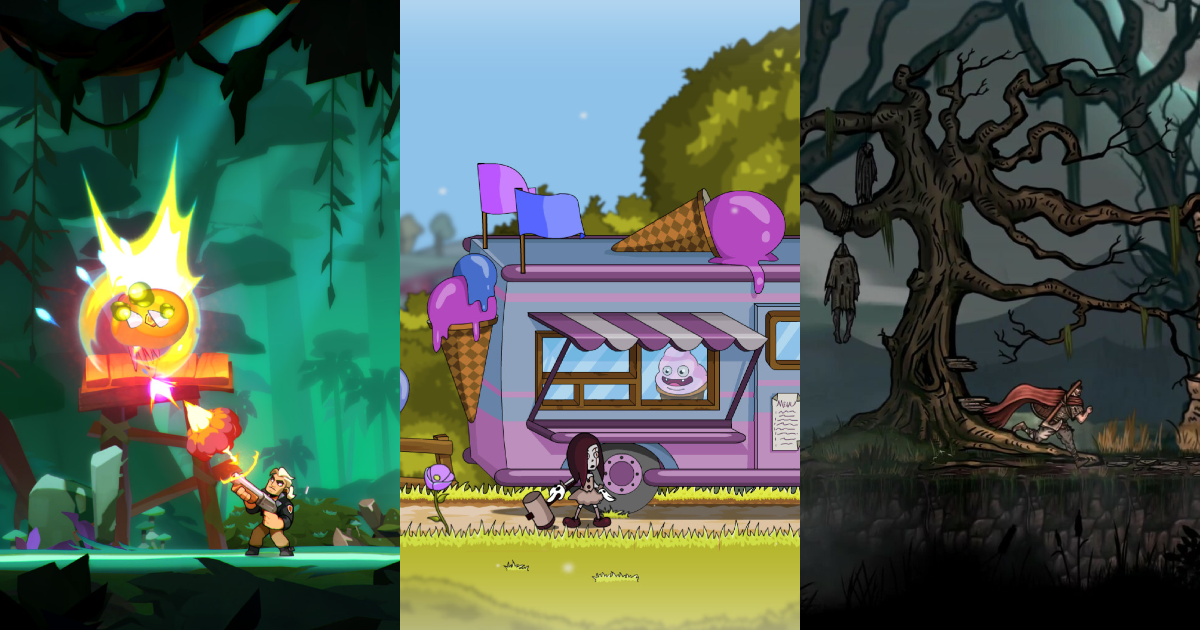What's Happening in the Metroidvania Market — Expert Assessment of the Genre
In the wake of Hollow Knight: Silksong's success, at App2Top, we talked with developers of metroidvanias about the state of the genre—development challenges, competition, and whether these games can be profitable. This discussion included Leonid Rastorguev, Slava Gris, and Vyacheslav Berezovsky.
1. What is currently happening in the metroidvania genre?
Leonid Rastorguev — Creative Director of Blast Brigade vs. the Evil Legion of Dr. Cread
Even players who aren't particularly interested in the genre know that the recent release of the second part of the legendary Hollow Knight is making waves. Silksong sold about 5 million copies on its first day, simultaneously crashing the Steam and PS Store payment systems. However, if we look back a bit, we can see that since the release of the first part, the genre has remained consistently popular among developers. Each year, three to five "major" games are released, along with a couple dozen smaller ones. Projects emerge from both Asian studios and Western colleagues.
Slava Gris — Author of Catmaze and Fearmonium
The same can be said about other genres—pure representatives are almost non-existent. Most games cannot be strictly categorized into one genre or another. It's all turned into a set of tags. Is the brilliant Soul Reaver a metroidvania? Or Control? Nevertheless, Control carries the "metroidvania" tag, even though it contrasts sharply with genre pioneers like Metroid and Castlevania. Some even debate whether Bloodstained is a metroidvania—there's a tag "Igavania" devised for such games.
In other words, games now incorporate so much from their peers that purebreds of the genre are practically nonexistent. For instance, elements from Soul-like games are now so integrated into classical metroidvania mechanics that it's hard to distinguish what is classical and what is the trendy borrowing from "Dark Souls."
Vyacheslav Berezovsky — Creative Director of Volkolak: The Will of Gods
It's business as usual. Metroidvanias remain quite a niche market for business; however, they are a popular genre among budding developers.
2. How strong is the competition in the niche?
Leonid Rastorguev — Creative Director of Blast Brigade vs. the Evil Legion of Dr. Cread
This is where things get interesting. There are indeed many projects in the genre, and they vary widely in quality. The range goes from completely "garage" indie to Prince of Persia, developed with Ubisoft's money. Meanwhile, the audience size remains relatively unchanged. The genre is niche, demanding player skill, has a high entry barrier, and complex navigation. Consequently, there is significant income disparity. Even expensive and high-quality projects often fail to break even. Prince of Persia, for Ubisoft, is considered a commercial failure, and Mandragora and Ender Magnolia, judging by Steam statistics, have only sold a few thousand copies. These aren't isolated stories; many projects in the genre fall critically short in sales.
Slava Gris — Author of Catmaze and Fearmonium
Steam returns 1500 results for a Metroidvania search. For Horror, there are 14,000. For Action, there are 34,000. Whether competition will smother you when developing a metroidvania depends not on the fact that you're making a metroidvania, but on what other tags you add to it. Want to make an isometric, turn-based metroidvania with card game elements? Competition will be low. Want to create a pixel metroidvania that follows all the genre's conventions? Competition will be high.
How much pressure other developers put on you depends on what elements, mechanics, and tags you incorporate into your product besides the "metroidvania" tag.
Vyacheslav Berezovsky — Creative Director of Volkolak: The Will of Gods
The competition is small compared to other genres. But the audience is targeted, excluding the Hollow Knight phenomenon.
3. Is it true that games in this genre are easier to make than others (at least when we're talking about classic 2D projects)?
Leonid Rastorguev — Creative Director of Blast Brigade vs. the Evil Legion of Dr. Cread
Let's say, this genre has a pretty clear structure, so it decomposes well. You need to create 10–20 hours of gameplay: that's 10–15 biomes, about the same number of bosses, 5–10 ability-keys, 30–50 types of enemies, and so on. It seems straightforward enough to sit down and assemble content. You can even do it solo if you're ready to master a wide array of skills. But that's only what's on the surface.
In reality, from the perspective of creating game mechanics, the genre isn't much simpler than Souls-like games. Visually, yes, you can cut costs. But players are very demanding when it comes to 2D stylization. You need either strong art direction or unique visual features that will sell the image, since that's where players get their first impressions.
This reminds me of the pixel art situation ten years ago. The style became trendy, and developers rushed to make pixel games, thinking it was a cheaper option. Nowadays, the quality standard has been set, and it turns out that pixel art is not cheaper than other styles and, in places such as character animation, even more expensive.
Slava Gris — Author of Catmaze and Fearmonium
A friend of mine, with whom I started making games about 12 years ago, built his entire development path on creating horror games. I focused on making metroidvanias. After these 12 years, who among us finds it easier to make a metroidvania, and who a horror game? If we switch places, we'd essentially reset all our experience and make two bad games.
How easy it is for you to make a game in any genre depends on your playtime and experience. If you don't have experience in making a metroidvania/strategy/RPG, it will be harder to make one than it is to do what you already know how to do.
Vyacheslav Berezovsky — Creative Director of Volkolak: The Will of Gods
This is a misconception. In terms of coding and animation, it's one of the most challenging subgenres of 2D action-platformers. The code is complex, there are numerous mechanics, complex boss behavior, and a lot of work is needed on visuals and animations to keep players interested. It's much easier to make a 3D project with assets.
4. What is the main difficulty in creating metroidvanias?
Leonid Rastorguev — Creative Director of Blast Brigade vs. the Evil Legion of Dr. Cread
If we talk specifically about the mechanical side of the genre, not addressing unique features and selling visuals, there are two pillars that need to be refined to perfection — movement and the combat system. Metroidvanias mostly alternate between platform sections, combat encounters, and bosses. All this demands very responsive controls, so the player can feel the position of their character down to the pixel, clearly see animation windows for parrying and dodging, and understand and feel all the timing of their character's and enemies' attacks. This demands an immense amount of iterative work for tuning and polishing. I even had a separate lecture on this topic based on my experience working with Blast Brigade.
Slava Gris — Author of Catmaze and Fearmonium
My personal challenges are likely hard to project onto other developers, as I create niche games and have a quite unique playstyle. For example, I enjoy Chronicles of Teddy a hundred times more than Hollow Knight, and the Castlevania games on NDS will likely never leave my personal pedestal (Order of Ecclesia and Portrait of Ruin look down condescendingly at the crippled — Symphony of the Night).
For me, the difficulty lies in trying to understand what modern players like and, more importantly, why. Why is running from marker to marker on a map more fun than trying to memorize the map yourself and exclaiming "hooray" when you finally find the needed passage on your own? Why is saving progress upon death, returning to a bonfire, and running to where you died to recover your items more fun than the risk and thrill of possibly dying and losing all progress with classic save mechanics? I’m still searching for the answers to these questions.
The hardest part is sitting on two chairs: making a game that I enjoy and one that modern players will enjoy.
Vyacheslav Berezovsky — Creative Director of Volkolak: The Will of Gods
Creating an interconnected world, balancing gameplay, hardcore elements, and narrative.
5. How much could it cost to develop a competitive game in the genre?
Leonid Rastorguev — Creative Director of Blast Brigade vs. the Evil Legion of Dr. Cread
It’s worth mentioning that this market is segmented by development costs, consequently influencing sales expectations. There are indie projects, which might be developed by 1-2 people over years with a budget of $10,000–$20,000 (for example, Haiku the Robot). For such projects, selling 10,000 copies is a success. However, without marketing (which is common for indies), reaching that sales level could be as challenging as reaching 300,000 sales with a publisher’s help.
Then there are "major" projects that are more visible in the market, like Blasphemous or Nine Sols. They are usually created by teams of 10+ people over 2-3 years, sometimes longer. The budgets are about $0.5–1 million. And, of course, there are top-tier titles like Ori, Prince of Persia, and Metroid Dread. There, budgets are significantly higher.
Slava Gris — Author of Catmaze and Fearmonium
On all my games, I’ve only spent my time and not a penny, which is why the question is unclear to me. I always evaluate a game's success not by the number of reviews or sold copies but by return on investment. Prince of Persia: The Lost Crown sold more than three million copies. Nevertheless, for Ubisoft, it was a failure, and the development team, if I'm not mistaken, has been disbanded. Can this game be considered competitive with such circumstances?
For people who spent millions on game development, one hundred thousand copies sold will not be enough. They will bankrupt, fall apart, and stop supporting the game. For those who made a game on a shoestring without investments, selling just one copy could be enough to break even and feel confident among other genre representatives.
Vyacheslav Berezovsky — Creative Director of Volkolak: The Will of Gods
From 5 to 25 million rubles, depending on the duration of the game, visuals, and team.
6. What distinguishes leaders of the genre from less successful projects?
Leonid Rastorguev — Creative Director of Blast Brigade vs. the Evil Legion of Dr. Cread
No surprises here. Unique ideas and features, unusual visualization, a popular franchise. In other words, it's the same as in other genres. The genre has cemented itself, filled with projects, and it turns out, as everywhere, players want a new experience. Simply making a Hollow Knight clone won't suffice for earning money.
A sequel, unfortunately, doesn’t guarantee success. Blasphemous 2, Guacamelee 2, Ender Magnolia (a continuation of Ender Lilies) sold worse than their first parts. And, of course, publishing and marketing are crucial. You can't rely on going viral or word of mouth anymore. Projects are too numerous; without proper promotion, it's easy to get lost.
Slava Gris — Author of Catmaze and Fearmonium
The experience of Silksong shows: virality. So many games have been released in general (and in the metroidvania genre—I already mentioned there are around 1500 on Steam alone, not to mention retro games in the genre), that new games are unwanted—to live long enough not to outlast all existing ones.
We don't need a new product; we need noise around the new product. The illusion that it's "in style" and possessing it makes us feel part of something cool, big, and modern. Hollow Knight has about 12 million sales on Steam. Silksong was on the wishlists of 5 million people. Judging by the achievement statistics, about 10% of players completed Hollow Knight. That's just over a million. The remaining 4 million wishing to buy Silksong haven’t even finished what the first part had to offer. By the way, 25% of those who bought Hollow Knight never even launched it.
This applies to books, movies, and comics—we live in an age of incredible overabundance. To become a leader in such a scenario, you need to obscure the consumer's view with informational noise and conceal the fact that even if games stopped releasing today—one would still never finish all that’s already out.
Vyacheslav Berezovsky — Creative Director of Volkolak: The Will of Gods
A significant development time—starting from five years. Having experience is critical. For example, before starting work on Hollow Knight, the developers already had 15 years in game development.
7. Can this genre be profitable? Very profitable?
Leonid Rastorguev — Creative Director of Blast Brigade vs. the Evil Legion of Dr. Cread
Yes, there is a demand for games in the genre. Every year we see successful projects. In 2023, for example, Laika: Aged through Blood was released, and in 2024—Nine Sols. There are few, but they exist.
As for "a lot of money", well, of course, there's the phenomenal success of Silksong, but I wouldn't look at it as a standard because this game has definitely gone beyond the genre's audience, much like Baldur’s Gate 3 did in its time. However, unlike the latter, I'm sure that a significant portion of Silksong players will not only never finish the game but likely won't try anything else in the genre.
Slava Gris — Author of Catmaze and Fearmonium
Nowadays, anything can make money. I've seen people sell rocks, and someone buys them. I live off the income from Fearmonium and Catmaze, and it's enough for me. However, it wouldn't be enough if the development budget was more than zero rubles: I have no publisher, I don't have to cover anyone's investments, and all income from the games goes to me. If I were covering investments, sharing with a publisher, and the games were developed with shared stakes—I'd say no, the genre doesn't make money.
In short, as always: it doesn't matter how much you earned—it matters how much you spent. If you spend millions on game development, the risk of earning nothing grows proportionally to the money spent. This applies to games in any genre.
Vyacheslav Berezovsky — Creative Director of Volkolak: The Will of Gods
It can become profitable if the game becomes a hit. An advantage of metroidvanias is the low development cost, dedicated fans, and a niche but entirely engaged audience that buys any good game in the genre, making it easier to break even. There's less competition.
8. In light of the almost supernatural success of Silksong, should we expect a new wave of games in the metroidvania genre?
Leonid Rastorguev — Creative Director of Blast Brigade vs. the Evil Legion of Dr. Cread
Since the release of the first Hollow Knight, the genre has been active, possibly even too much.
Both parts are undoubtedly magnificent, inspiring and will continue to inspire many aspiring developers.
Regarding "major" titles in the genre, I don't expect a new wave here, but rather, if I were a team with an appropriate budget, I would be doing something entirely different right now. Silksong was developed over seven years on a huge budget by genre standards. It set a new quality bar for the genre in terms of visual solutions and game quality. But it didn’t expand the audience; it garnered sales from adjacent audiences due to the fame of the first part and overall hype. In my opinion, it is impossible to recoup development budgets comparable to Hollow Knight Silksong's costs just on the real metroidvania audience. Therefore, I expect a decrease in the number of noticeable projects.
Slava Gris — Author of Catmaze and Fearmonium
Silksong, being a damn viral game, might play a dirty trick on developers of other games: often what is forgiven to big and popular games will serve as a reason to tear unknown "indies" apart. Silksong revealed itself as a game players find brutally difficult. I fear that some developers might think that the success of Hollow Knight’s sequel lies in its high difficulty and some not-so-convenient mechanics. They will start blindly copying elements that Silksong consists of, not considering the context in which this game exists.
Players are willing to suffer and dig into a product that is popular, because it's embarrassing “not to understand a popular game.” If a player fails to understand and struggled in a game with a hundred reviews on Steam, the fault will lie with the game and its developer. So, answering the question, I think a couple of talentless copies of Silksong will appear, and otherwise, the situation won’t change. Games will keep launching at a rate of more than 30 a day.
Vyacheslav Berezovsky — Creative Director of Volkolak: The Will of Gods
Possibly. We’ll wait and see.
9. Is it worth creating metroidvanias?
Leonid Rastorguev — Creative Director of Blast Brigade vs. the Evil Legion of Dr. Cread
If you think you can break into the genre on the wave of hype surrounding Hollow Knight, that moment passed about five years ago. My personal opinion: expectations for projects in the genre are so high that it's only worth entering if you're a skilled developer with experience in metroidvanias or Souls-likes and know exactly what you're doing. Or if you have amazing art direction and world concept. Or if you've come up with something truly revolutionary for the genre. Ideally, all three should coincide. Because today, to avoid going bankrupt on a metroidvania, you must hit a big success. And the genre isn’t the easiest to aim for a hit.
Slava Gris — Author of Catmaze and Fearmonium
You should do what you love and what you enjoy developing in. If the genre doesn't appeal to you, what's the point in suffering and attempting to create a product that doesn't even excite you? You’re unlikely to push yourself to work and develop in the direction you’re aiming for. This can lead to burnout, depression, and so on. Make what you’re passionate about and enjoy playing. This way, at least, you'll finish the game with greater probability. Forget whether it’s a popular genre at the moment. You’ll complete it in a year or two—by then, your genre might come back into vogue, like boomer shooters did.
And if the question is about money—don’t make games at all for money. Game development is a business with so many risks, pitfalls, and such short planning horizons that for the sake of earning money, I’d suggest opening a little shop instead of making a metroidvania. It’s more reliable.
Vyacheslav Berezovsky — Creative Director of Volkolak: The Will of Gods
If it’s what you want, then of course, you should. But not for earning big money. Metroidvanias are primarily author projects. For business, a clone simulator with coop and mediocre visuals (cheap, fast, profitable) would be more suitable.



